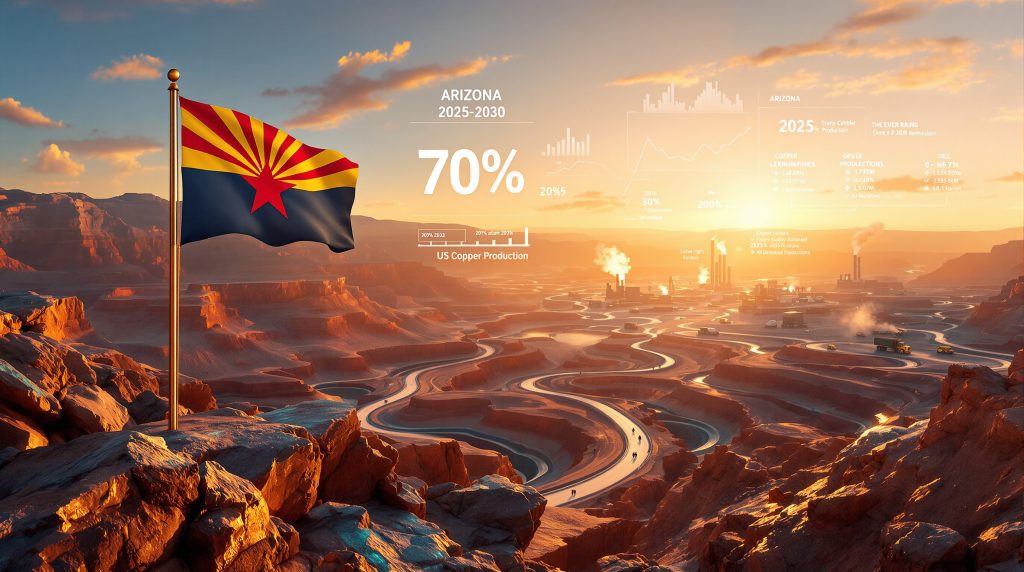The convergence of federal policy changes, surging copper prices, and supply chain vulnerabilities has created an unprecedented opportunity for reopening copper mines in Arizona. Mining executives are increasingly viewing dormant Arizona operations as strategic assets rather than stranded investments, particularly as domestic mineral security becomes a national priority. Furthermore, copper price insights indicate sustained bullish sentiment supporting these reopening initiatives.
Arizona's established mining infrastructure provides a compelling advantage over greenfield developments. The state's 150-year mining heritage has created a foundation of processing facilities, transportation networks, and skilled workforce populations that can be reactivated rather than built from scratch. This infrastructure advantage becomes particularly valuable when considering the 7-12 year development timelines typical for new mining projects.
The Perfect Storm Driving Mine Reopening Decisions
Federal policy realignment under the Trump administration represents what industry leaders characterize as a fundamental critical minerals policy shift for the mining sector, prioritising domestic production capabilities and supply chain security. The designation of copper as a critical mineral under federal guidelines has streamlined permitting processes and introduced tax incentives specifically targeting domestic production capabilities.
Copper price trajectories have reached multi-year highs, with the London Metal Exchange reflecting sustained demand growth driven by global electrification initiatives. The International Energy Agency projects a 24% increase in copper demand by 2035, creating supply-demand imbalances that favour reopening copper mines in Arizona over waiting for new discoveries.
Supply chain disruptions exposed during recent global events have highlighted the risks of import dependency. Currently, the United States relies on imports for approximately 40% of its copper needs, with Chile, Canada, and Mexico serving as primary suppliers. This dependency creates strategic vulnerabilities that domestic production can help mitigate.
Arizona's Dominant Position in U.S. Copper Production
| Metric | Arizona | National Context |
|---|---|---|
| Share of U.S. Production | 70% | Leading state |
| Active Major Operations | 6+ mines | Morenci, Sierrita, Miami |
| Historical Significance | 150+ years | Continuous mining heritage |
| Infrastructure Status | Established | Processing facilities, transport corridors |
Arizona's dominance in American copper production stems from geological advantages and decades of infrastructure development. The state's major operations including Freeport-McMoRan's Morenci mine, South32's Sierrita operation, and KGHM International's Miami facility provide a foundation for supporting additional production capacity through reopened facilities. In addition, modern mining technology enables these facilities to achieve higher efficiency standards than historical operations.
Which Shuttered Arizona Copper Mines Are Being Considered for Reopening?
BHP is actively evaluating four shuttered copper mines in Arizona's Globe-Miami region, including the historic Magma mine acquired in 1996. This strategic review encompasses not only the mines themselves but also the potential for reprocessing tailings from historical operations to extract additional copper using modern technologies.
The Globe-Miami mining district offers unique advantages for reopening projects, including existing processing infrastructure, established transportation corridors via State Route 60, and proximity to skilled mining professionals. These factors significantly reduce the capital requirements and timeline compared to developing entirely new operations.
Globe-Miami Region: The Historic Mining Corridor Revival
The Magma mine operated continuously from 1910 to 1996, producing over 12 billion pounds of copper during its operational lifetime. The facility's 29-year idle status presents both challenges and opportunities, as modern extraction technologies can potentially recover copper from previously uneconomical ore grades and historical tailings.
Legacy operations in the Globe-Miami region benefit from proven ore reserves and geological data spanning decades of production. This historical knowledge base reduces exploration risk and provides detailed understanding of ore body characteristics, mineralisation patterns, and optimal extraction methods.
Transportation infrastructure remains intact throughout the mining corridor, with established rail access and highway connections facilitating movement of concentrate to processing facilities. The region's proximity to major population centres also ensures availability of skilled workforce and support services.
Resolution Copper: The Game-Changing Development Project
Resolution Copper represents one of the largest undeveloped copper deposits in North America, containing approximately 1.8 billion metric tons of ore with an average grade of 1.5% copper, potentially supplying 25% of total U.S. copper demand once operational.
The Resolution Copper project operates as a joint venture between Rio Tinto (55%) and BHP (45%), formed in 2004 to develop deposits located near Superior, Arizona. This partnership combines international mining expertise with domestic market knowledge to advance one of North America's most significant undeveloped copper resources.
The project entered a new development phase in 2023, with environmental impact assessment processes ongoing. However, the timeline faces regulatory complexities related to federal land exchanges and environmental compliance requirements that could extend development schedules.
Economic impact projections suggest Resolution Copper could generate substantial revenue for Arizona communities and state coffers once operational. The scale of the deposit positions it as a cornerstone project for American copper self-sufficiency initiatives.
What Economic Factors Make Arizona Mine Reopening Financially Viable?
Mine reopening projects offer compelling economic advantages over greenfield development, requiring 40-60% less capital investment due to existing infrastructure and proven reserves. This cost differential becomes particularly significant in current capital markets where mining project financing faces increased scrutiny and higher interest rates.
Timeline advantages provide additional economic benefits, as reopening projects can achieve production within 2-4 years compared to 7-12 years for new developments. This compressed timeline reduces financing costs and allows producers to capitalise on current favourable commodity price environments.
Copper Market Fundamentals Supporting Investment Decisions
Global electrification initiatives are driving unprecedented copper demand growth, with renewable energy infrastructure requiring significantly more copper per unit of electricity generation compared to traditional fossil fuel systems. Consequently, surging copper demand creates favourable conditions for reopening dormant facilities.
Supply-demand imbalances have created sustained price support for copper, with global mine supply facing deficits beginning in 2025-2026 as new project development lags behind demand growth. These market fundamentals provide revenue stability for reopening investments.
Treatment and refining charge markets reflect tight concentrate supply conditions. Japan, Spain, and South Korea issued joint warnings about plunging treatment charges, with some Chinese smelters processing copper at zero or negative rates, indicating severe supply constraints that benefit concentrate producers.
Premium pricing for domestically sourced critical minerals adds additional revenue potential for Arizona operations. National security considerations and supply chain resilience initiatives create market premiums for domestic copper supplies.
Cost-Benefit Analysis of Reopening vs. New Development
| Factor | Mine Reopening | Greenfield Development |
|---|---|---|
| Initial Capital | 40-60% lower | Full development costs |
| Timeline to Production | 2-4 years | 7-12 years |
| Infrastructure Costs | Existing/Upgradeable | Complete new build |
| Permitting Complexity | Streamlined process | Full environmental review |
| Resource Risk | Proven reserves | Exploration dependent |
| Workforce Availability | Established communities | New recruitment required |
Infrastructure rehabilitation costs represent the primary capital requirement for reopening projects, involving structural assessments of shafts, hoists, and underground workings. However, these costs remain substantially lower than complete facility construction required for greenfield developments.
Equipment procurement represents a significant consideration, with major mining equipment currently facing 18-24 month delivery timelines due to global supply chain constraints. However, some reopening projects may utilise refurbished equipment or benefit from existing machinery stored at facility sites.
How Are Policy Changes Accelerating Arizona Copper Mine Development?
The Trump administration's approach to critical minerals represents what industry executives describe as a breathtaking shift for the mining sector, prioritising domestic production capabilities and supply chain security. This policy realignment has created regulatory frameworks specifically designed to support domestic copper production initiatives.
Federal critical minerals strategy implementation includes expedited permitting processes for domestic copper projects, reducing typical NEPA review timelines that historically required 7-10 years for major mining operations. These streamlined processes specifically target projects that enhance domestic supply capabilities.
Federal Critical Minerals Strategy Impact
Copper's designation on the U.S. Geological Survey's list of 50 critical minerals deemed essential to economic and national security has established regulatory frameworks prioritising domestic production. This designation provides access to expedited review processes and federal support programmes.
Tax incentives through the Inflation Reduction Act include Advanced Manufacturing Production Credits specifically applicable to domestic critical mineral production. These incentives improve project economics by reducing effective tax rates for qualifying operations.
National security considerations have elevated copper to strategic mineral status, creating policy frameworks that view domestic production as essential infrastructure rather than purely commercial activity. This shift influences regulatory decision-making and resource allocation priorities.
State-Level Support Mechanisms
Arizona's mining-friendly regulatory environment provides additional advantages for reopening projects, with established frameworks for permitting and environmental compliance that complement federal initiatives. The state's experience with mining regulation reduces bureaucratic uncertainties common in other jurisdictions.
Workforce development programmes specifically target skilled mining positions, addressing labour shortages that could constrain production expansion. These programmes coordinate with educational institutions and industry partners to ensure adequate skilled workforce availability.
Infrastructure investment commitments at state and local levels support mining operations through improved transportation networks, utility capacity, and communication systems. These investments reduce operational costs and improve project viability.
What Modern Technologies Are Enabling Sustainable Mine Reopening?
Advanced extraction and processing technologies have fundamentally transformed the economics of mine reopening by enabling recovery of copper from previously uneconomical ore grades and historical waste materials. These technological improvements make idle facilities viable under current market conditions.
Automated mining systems reduce operational costs by 15-20% while improving worker safety by removing personnel from hazardous underground environments. These systems also provide more precise extraction capabilities, maximising ore recovery rates and reducing waste generation.
Advanced Extraction and Processing Methods
Modern flotation and leaching technologies can economically extract copper from historical tailings with grades as low as 0.15-0.20%, compared to 0.40%+ required by older technologies. This capability transforms historical waste into valuable resources, extending mine life and improving project economics.
Tailings reprocessing capabilities offer additional revenue streams for reopened operations, utilising existing waste materials that previous mining activities left behind. Advanced processing methods can extract not only copper but also precious metals and other valuable minerals from these materials.
Improved ore processing technologies maximise recovery rates from primary mining activities, ensuring more complete extraction of valuable minerals from processed ore. These improvements reduce waste generation and increase revenue per ton of ore processed.
Environmental Management and Water Conservation
Modern copper mining operations in Arizona utilise advanced water recycling systems that can reduce freshwater consumption by up to 85% compared to traditional methods, addressing critical environmental concerns in arid regions.
Closed-loop water systems minimise environmental impact by recycling process water through multiple treatment stages, reducing freshwater requirements and eliminating liquid waste discharge. Furthermore, South32's Sierrita operation near Tucson demonstrates this technology's effectiveness, recovering over 80% of process water.
Renewable energy integration provides operational cost reduction and environmental benefits, with several Arizona copper mines deploying solar power installations. Freeport-McMoRan's Bagdad mine implemented a 65-megawatt solar facility in 2024, demonstrating renewable energy viability for large-scale mining operations.
Land reclamation technologies enable restoration of post-mining landscapes to productive uses, addressing environmental concerns whilst creating long-term community benefits. These technologies transform former mining areas into recreational facilities, wildlife habitat, or agricultural land.
What Timeline Should Investors Expect for Arizona Copper Mine Reopening?
Mine reopening projects typically require comprehensive evaluation phases before production decisions, with feasibility studies and resource confirmation drilling representing initial milestones. These studies assess infrastructure condition, ore reserve viability, and regulatory requirements.
BHP's evaluation of four Globe-Miami region mines represents early-stage analysis that could extend 12-18 months before final reopening decisions. These assessments must address 29 years of facility idleness and evaluate infrastructure modernisation requirements.
Near-Term Development Phases (2025-2027)
Infrastructure Assessment and Planning:
- Comprehensive structural engineering evaluations of shafts, hoists, and underground workings
- Water management system assessment and rehabilitation planning
- Environmental baseline studies and impact assessments
- Community engagement and stakeholder consultation processes
Regulatory and Permitting Activities:
- Federal and state mining permit applications and reviews
- Environmental compliance documentation and approvals
- Water rights verification and usage permit applications
- Safety and health administration compliance certifications
Equipment and Workforce Preparation:
- Major mining equipment procurement with 18-24 month delivery timelines
- Skilled workforce recruitment and training programme implementation
- Contractor selection and service agreement negotiations
- Supply chain establishment and logistics optimisation
Production Ramp-Up Projections (2027-2030)
Key Development Milestones:
-
Initial production testing and system commissioning
- Limited production trials to verify processing capabilities
- Equipment performance optimisation and troubleshooting
- Quality control system implementation and validation
-
Full-scale operational capacity achievement
- Gradual production increases to design capacity levels
- Workforce expansion and shift pattern optimisation
- Continuous improvement implementation and efficiency gains
-
Market integration and customer relationship development
- Concentrate sales agreements and delivery schedule establishment
- Transportation and logistics optimisation for sustained operations
- Financial performance monitoring and investor reporting
-
Expansion planning and long-term sustainability
- Additional resource development and reserve expansion
- Technology upgrade evaluation and implementation planning
- Community benefit programme development and execution
How Will Reopened Arizona Mines Impact Global Copper Supply Chains?
Domestic copper production expansion through reopening copper mines in Arizona directly addresses import dependency issues that create strategic vulnerabilities for American manufacturing and infrastructure development. Current import levels of approximately 40% represent significant exposure to international supply disruptions and geopolitical tensions.
The combined market value of the world's 50 most valuable mining companies reached nearly $2 trillion in Q3 2025, reflecting strong investor interest in copper and critical mineral producers. This valuation growth demonstrates market confidence in long-term demand fundamentals supporting reopening investments.
Reducing Import Dependency and Geopolitical Risk
Arizona mine reopening creates strategic buffer capacity against international supply disruptions, reducing reliance on imports from politically unstable regions. Recent geopolitical tensions have highlighted risks associated with concentrated supply chains and foreign dependency for critical materials.
Strengthening North American copper supply security supports regional economic integration and reduces transportation costs associated with intercontinental shipping. Domestic production also eliminates currency exchange risks and trade policy uncertainties affecting international purchases.
Chinese copper export activity reflects tight global supply conditions, with smelters shipping up to 50,000 tons to international warehouses as record London prices create arbitrage opportunities. This activity demonstrates global supply chain stress that domestic production can help alleviate.
Supporting Domestic Manufacturing and Clean Energy Transition
Local copper availability supports domestic renewable energy infrastructure development by reducing material costs and ensuring supply reliability for solar installations, wind turbines, and electric vehicle charging networks. These applications require substantially more copper than traditional energy systems.
Reduced transportation costs benefit domestic manufacturers by eliminating international shipping expenses and delivery uncertainties. However, US copper project insights suggest that local copper supplies also provide more responsive delivery schedules and flexible ordering arrangements compared to international suppliers.
Job creation across the mining and processing value chain extends beyond direct mining employment to include transportation, equipment supply, professional services, and community support activities. These economic multiplier effects provide regional development benefits.
What Challenges Could Delay Arizona Copper Mine Reopening Projects?
Regulatory complexity remains a significant challenge for mine reopening projects, despite policy changes intended to streamline processes. Federal land use approvals and environmental compliance requirements must address current standards that may differ significantly from historical operational permits.
Water rights allocation represents a critical constraint in Arizona's arid environment, where historic mining operations may hold existing rights but reactivation requires state regulatory approval under prior appropriation water law. Competition for limited water resources creates potential delays and cost increases.
Regulatory and Environmental Hurdles
Environmental compliance requirements for reopened mines must address current Clean Water Act, Clean Air Act, and NEPA standards that often require significant upgrades from historical operational practices. These upgrades can substantially increase reopening costs and timeline requirements.
Community relations and stakeholder engagement processes have become more complex since many Arizona mines originally operated, requiring extensive consultation and benefit-sharing arrangements. Resolution Copper's extended permitting process demonstrates these challenges' potential impact on project timelines.
Federal land use approvals involve multiple agencies and complex procedures, particularly for projects requiring land exchanges or modifications to existing federal land designations. These processes can extend regulatory timelines beyond initial projections.
Technical and Financial Risk Factors
Mine reopening projects face unique challenges including ageing infrastructure assessment, updated safety compliance, and workforce recruitment in competitive labour markets where experienced mining professionals command premium compensation.
Infrastructure modernisation costs can escalate significantly when detailed engineering assessments reveal extensive rehabilitation requirements for facilities idle for 25-30 years. Underground workings may face groundwater infiltration, roof deterioration, and equipment corrosion requiring major investments.
Skilled workforce availability presents challenges in competitive labour markets where experienced mining professionals have multiple employment opportunities. Training programmes require 6-12 months to develop operational competency, potentially constraining production ramp-up schedules.
Capital market conditions affect project financing availability and costs, with current higher interest rates increasing project financing expenses. M&A activity in the mining sector remains sluggish due to high valuations and operational setbacks, potentially limiting financing options.
Equipment availability and delivery timelines create project scheduling challenges, with major mining equipment facing 18-24 month procurement periods. Supply chain constraints affecting mining equipment manufacturers could extend these timelines further.
FAQ: Arizona Copper Mine Reopening
Which Companies Are Leading Arizona Copper Mine Reopening Efforts?
BHP is actively evaluating four shuttered mines in Arizona's Globe-Miami region, including the historic Magma mine acquired in 1996. The company's strategy encompasses both facility reopening and tailings reprocessing to maximise domestic copper production capabilities.
Resolution Copper, a joint venture between Rio Tinto (55%) and BHP (45%), represents another major development initiative, though focused on new deposit development rather than reopening copper mines in Arizona. This project involves one of North America's largest undeveloped copper deposits.
Major mining companies including Freeport-McMoRan, South32, and KGHM International continue operating existing Arizona facilities whilst evaluating expansion opportunities that could include reopening adjacent shuttered operations.
How Long Does It Take to Reopen a Shuttered Copper Mine?
Typical reopening timelines range from 2-5 years depending on infrastructure condition, regulatory requirements, and market conditions. Projects involving facilities idle for extended periods may require longer timelines due to extensive rehabilitation needs.
Infrastructure assessment phases typically require 6-12 months to evaluate structural integrity, equipment condition, and modernisation requirements. These assessments determine rehabilitation scope and cost estimates for final investment decisions.
Regulatory approval processes can extend 12-24 months, though streamlined procedures for critical mineral projects may reduce these timelines. Environmental compliance requirements often represent the longest component of regulatory review processes.
Equipment procurement and installation phases typically require 18-24 months due to current supply chain constraints affecting mining equipment manufacturers. Major processing equipment may require longer delivery periods depending on customisation requirements.
What Environmental Protections Apply to Reopened Copper Mines?
Modern reopening projects must comply with current environmental standards regardless of historical operational practices, often requiring significant upgrades to meet Clean Water Act, Clean Air Act, and waste management regulations.
Comprehensive environmental management plans address water usage, air emissions, waste handling, and land reclamation requirements. These plans must demonstrate compliance with current regulatory standards and incorporate modern environmental protection technologies.
Water management systems require closed-loop recycling capabilities that can achieve 85% water recycling rates, significantly reducing freshwater consumption compared to historical operations. Advanced treatment systems eliminate liquid waste discharge to surrounding environments.
Reclamation bonding requirements ensure adequate financial resources for post-mining land restoration activities. These bonds must reflect current reclamation costs and environmental protection standards rather than historical requirements.
Disclaimer: This analysis contains forward-looking statements and market projections that involve inherent uncertainties and risks. Commodity prices, regulatory decisions, and project timelines may differ from current expectations. Investment decisions should consider comprehensive due diligence and professional financial advice. Mining operations involve significant capital requirements, operational risks, and environmental responsibilities that may affect project viability and returns.
Ready to invest in the next major mineral discovery?
Discovery Alert instantly alerts investors to significant ASX mineral discoveries using its proprietary Discovery IQ model, turning complex mineral data into actionable insights. Understand why historic discoveries can generate substantial returns by visiting Discovery Alert's dedicated discoveries page, showcasing historic examples of exceptional outcomes, and begin your 30-day free trial today to position yourself ahead of the market.




